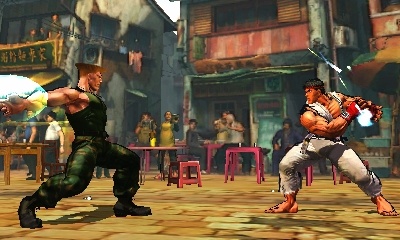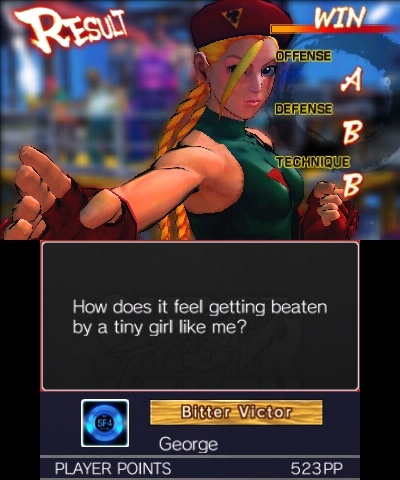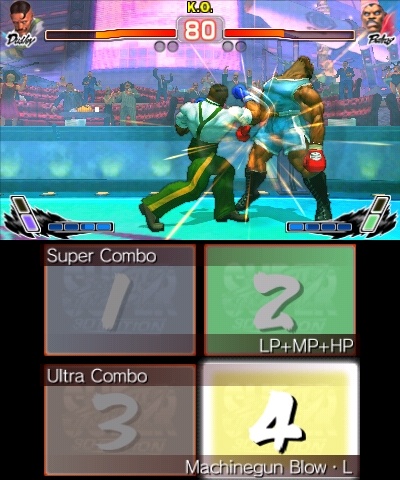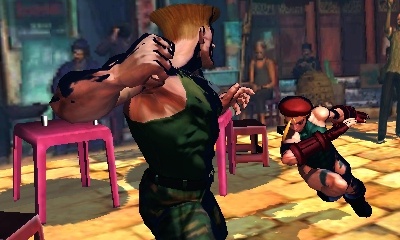Super Street Fighter IV: 3D Edition is more than just a simple port of the venerable fighting franchise. Several aspects of the game have been carefully tweaked to fit within the smaller confines of the 3DS, resulting in a fighting experience that feels every bit as impressive as its console cousins. Combat is fast, fluid, and visually spectacular and is as deep as it has ever been, making this one of the most technically brilliant fighters to have ever graced a handheld. There are some glaring omissions, though, such as leaderboards and an online tournament mode. Some compromises have also been made to accommodate the 3DS's button layout, but these are largely offset by a customisable touch-screen interface that makes the game more accessible than ever to newcomers.
The basic premise of the Street Fighter series has changed little since its debut in 1987. You play as one of 35 characters (all unlocked from the start), with the aim being to knock out your opponent with a range of kicks, punches, and special moves. All the characters from Super Street Fighter IV make a return, including series favourites such as Ryu, Chun-Li, and Blanka, along with newer additions such as C. Viper, Abel, and Rufus. Each is carefully balanced, so you are never at a disadvantage, no matter which character you fight with. With so many to choose from, there are a range of moves to suit everyone. For example, Abel is a slower, grapple-style character, specialising in short-range throws, while characters like Ryu and Sakura have faster, long-range attacks like Hadouken fireballs.
Learning moves and knowing which are the most effective against other fighters' attacks is key, making each match a strategic affair as you attempt to unravel your opponent's technique. If you're new to the series, a good place to start learning moves is Training mode, where you face off against a static dummy opponent. Though there's no tutorial, the controls are easy to pick up, and moves are listed via an onscreen command list. There are also various settings to adjust, such as your target's block mode, stun frequency, and regeneration levels. An input display shows you what buttons you're pushing, but it doesn't give you any guidance on the timing of your commands. If you're used to playing Street Fighter on a standard Xbox 360 or PlayStation 3 pad, then the control scheme will be familiar, though arcade-stick players will need time to adjust. By default, you move your character around using the circle pad or D pad, pushing back to block. One isn't necessarily easier to use than the other; your preference will depend largely on your own technique, but you might find the circle pad to be a little less accurate in frantic fights. Meanwhile, the face buttons launch light and medium kicks and punches, while the shoulder buttons launch heavy kicks and punches.
Combining directional moves with attack buttons launches special moves, such as Hadoukens, Shoryukens, and hurricane kicks. More-complex combinations using two or three attack buttons at once launch powerful EX attacks, as well as super and ultra attacks--devastating moves that can make all the difference in a fight. Using these moves relies on having enough charge in your EX and revenge meters, which are built up when you absorb hits or dish out damage. However, while your EX power rolls over to the next round, revenge does not. This adds yet more strategic depth to fights: you might decide to gather energy for your special, or deal out as much damage as possible using smaller EX moves. These moves aren't essential to winning a match, and a few well-placed kicks and punches can be just as effective.
Performing super and ultra combos has always been tricky, but on the 3DS the problem is exacerbated by its small shoulder buttons, which are difficult to press in conjunction with the face buttons in the heat of battle. A new control method has been implemented on the bottom screen that aims to make things easier, for both pros and newcomers. It displays four boxes, which are assigned to different moves. In Lite mode these automatically perform your character's super and ultra attacks, as well as two regular special moves. In Pro mode, the boxes are assigned to button combinations, such as all three kicks or punches, but can be customised to your liking. Newcomers will find Lite mode especially useful, because it lets you perform spectacular moves with little effort. While pros may scoff at the simplified controls, being able to unleash supers and ultras has never guaranteed a win; such is the depth and strategy of the game.

As well as EX, super, and ultra attacks, focus attacks make a return. Pressing and holding down the medium punch and kick buttons launches one of three levels of focus, with the strongest allowing you to absorb the first hit from your opponents and incapacitate them, giving you time to follow up with another attack before they hit the ground. You can also use focus to exit animations early to chain together some insanely impressive combos, though performing them requires serious thumb dexterity and some of your EX meter. You can learn many of these techniques in Challenge mode, where you're asked to perform a range of different combos against a dummy opponent. Each character has a set of combos to learn, which get more difficult as you progress. Some of the combos are especially challenging, but mastering them raises your abilities significantly, making fights easier to win and more impressive to watch.
Once you're comfortable with the controls, you can make your way through Arcade mode, which pits you against CPU-controlled characters in a number of fights. Though there's a story behind each character's motivations, they're weak at best, doing little to explain exactly why everyone is fighting each other. They're at least told in an attractive way, anime-style movies that play as you begin and when you complete Arcade mode. Interspersed throughout the fights are special stages, where you have to destroy a car or a set of rolling barrels within a set time limit--a nostalgic nod to Street Fighter II and a way to break up the action. There are a range of difficulty modes to choose from in Arcade mode, so no matter what your skill level, you can fight your way through. If you do battle it out on harder settings, be prepared for a challenge. Your CPU adversaries launch all manner of ultra attacks and combos, doing everything they can to defeat you--none more so than final boss Seth, whose seemingly endless supply of tricky moves feels as cheap as ever, making him incredibly frustrating to fight.
The real joy of Street Fighter lies in playing against human opponents, and there are a variety of options for doing so. Versus mode lets you play against other opponents via wireless, either nearby or on the same wireless network. Fights are smooth and free of any lag, so you've no excuses for losing battles, other than your own lack of skill. There is also a Download Play option, so you can fight against other 3DS owners with just one copy of the game, though the character selection is limited to Ryu. Battles can be played over the Internet too, with Quick, Custom, and Friend matches available. A Quick match pits you against a random player, while a Custom match lets you choose from a number of options before entering a match. You can change the number of rounds, the time limit, what region your opponents are from, their skill level, and whether they are using the Lite or Pro control method. A Friend match lets you play against anyone in your friends list, provided that they are playing at the same time too. You can set up a lobby and wait for them to join, but sadly there is no way to send a message to them from within the game; you have to exit and use the main 3DS message system to do so.

If you can't find an opponent online straightaway, you can turn on the fight request feature, which lets players challenge you to a battle while you're playing offline in Arcade mode. The performance of online battles against other players depends largely on your respective Internet connections. Matches are largely lag-free, though there are times when a bad connection causes the game to stutter significantly, making it tricky to compete. Disappointingly, there are no online leaderboards or tournaments. Though you do earn player points when you win battles, these are used to judge your skill level when you're being matched up with opponents. There is, however, a local player data section, where you can see statistics such as your total play time, your progress through Arcade mode, and the number of wins and losses you've had in versus battles. You also earn medals, which are like achievements, by completing tasks such as doing a special move 100 times or winning three matches in a row online.
You don't actually have to be playing to battle others, though, thanks to the 3DS' StreetPass feature. When your 3DS is in sleep mode, it automatically sends a figurine team of your choosing to battle other 3DS owners who have the feature turned on. It works much like a turn-based RPG battle, with each figurine's attributes such as their level, strength, and health points determining the outcome. How much you get out of StreetPass depends on how much interaction you have with other players, though if you do battle with people regularly, it's exciting to see your team grow stronger, and it's a nice diversion from regular fights. You're not stuck with a single set of figurines when you battle, though. You can trade with others or get new ones using your play coins, which are earned via the 3DS's pedometer. The more you walk, the more play coins you get. They can be traded in for figure points, which you can use to play a small minigame. A set of figurines spins around on the top screen, while a giant button appears on the bottom screen. Pushing the button stops the figurines from spinning and awards you with a new one for your collection. There are a lot to collect, all based on characters from within the game in various costumes and poses, which certainly extends the game's appeal if you're a completionist.
Whichever mode you're playing in, the visuals are extremely impressive. The familiar pseudo-cel-shaded character art returns, with thick black borders and splattered inkblots making each detailed combatant stand out from the background. Their animation is very smooth too, so each fight is a fluid and graceful experience that's heaps of fun. The backgrounds are less impressive, being largely static, but a variety of 3D models scattered across them add variety. Turning on 3D mode halves the frame rate from 60 frames per second to 30, but it's still eminently playable, and you're rewarded with a great 3D experience. Backgrounds stretch off into the distance, while fighters sit in front, and status bars hover over them, giving a feeling of depth. Ultra attacks benefit from 3D effects too, with explosions and fists flying out of the screen. A new 3D versus mode showcases the 3D effect even more with an angled over-the-shoulder view of your character. It's fun to play the first time, but soon its shortcomings become apparent. The angle makes it difficult to gauge how far away you are from your opponent and makes it tricky to know what direction you should be pushing on the D pad or circle pad to move your character. Serious fighters will most certainly want to stick to the standard view.
What's most impressive about Super Street Fighter IV: 3D Edition is how few compromises have been made to the core gameplay in its transition to the 3DS. From the fantastic visuals to the speed of combat, it's as great a fighting game as you'll find on a handheld, encompassing most of the features of the console versions. The lack of leaderboards and a tournament mode remains a mystery, but what matters most is that fighting remains fun and challenging. Whether you're a newcomer or a seasoned pro, Super Street Fighter IV: 3D Edition satisfies your fighting urges on the go, doing so with a level of style and depth that few fighting games can match.

